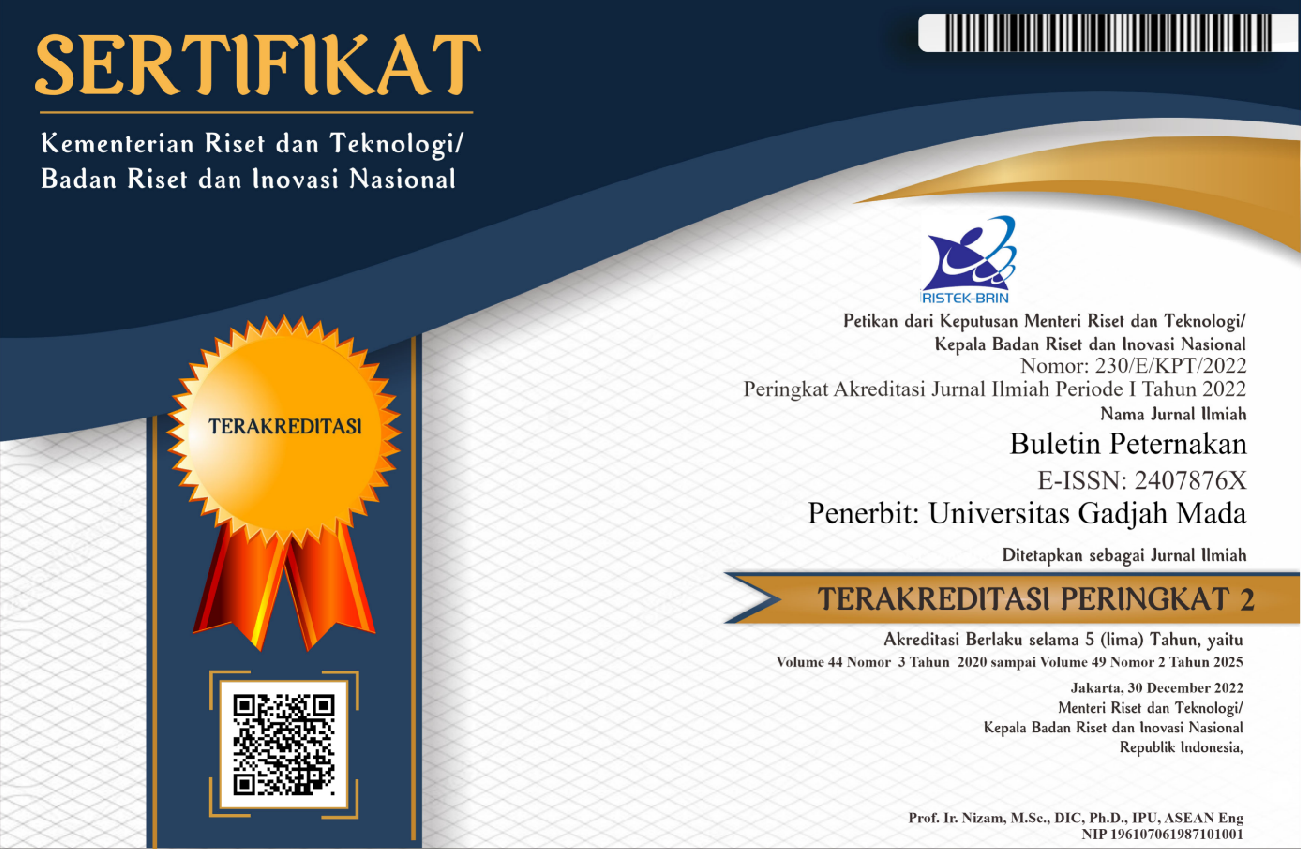Relationship Between Dairy Cattle Farming Motivation and Farmer’s Attitude Towards Portable Milking Machine
Fransiskus Trisakti Haryadi(1*), Adiarto Adiarto(2), Asmaul Fauzi Latif Fatkhur Rohman(3)
(1) Faculty of Animal Science, Universitas Gadjah Mada, Yogyakarta, 55281, Indonesia
(2) Faculty of Animal Science, Universitas Gadjah Mada, Yogyakarta, 55281, Indonesia
(3) Faculty of Animal Science, Universitas Gadjah Mada, Yogyakarta, 55281, Indonesia
(*) Corresponding Author
Abstract
The research was a case study for dairy cattle farmers being the members of Sarono Makmur Cooperative at Cangkringan District, Sleman Regency, Yogyakarta. The objectives of the research were (1) to explore dairy cattle farming motivation based on multidimensional approach, and (2) to analyze the relationship between the dimensions of dairy cattle farming motivation and the attitude of farmers towards the using of portable milking machine. 63 dairy cattle farmers, selected by purposive random sampling, participated in the research. Data were collected using survey method by interviewing the farmers based on the questionnaire already prepared. Spearman correlation was used to analyze the data. The results showed that most of farmers had high dairy cattle farming motivation including ease of farming management (95.24%), family labor utilization (93.65%), economic motives(92.06%),safety motives (92.06%), and land utilization (84.13%). As well as the attitudes, most of farmers (92.06%) had positive attitudes towards portable milking machine utilization. There were positive significant relationship between attitude and family labor utilization (P<0.05), safety in farming (P<0.05), economic motives (P<0.10), and land utilization (P<0.10). The conclusion of the research was that the high motives of family labor utilization, safety, economic, and land utilization to encourage the farmers raising dairy cattle, the high positive attitude of farmers towards the utilization of portable milking machine.
Keywords
Full Text:
PDFReferences
Alviawati, E., R. Rijanta, and S. R. Giyarsih. 2016. Household livelihood strategies of dairy cattle farmers in Kepuharjo Village, Indonesia, pre- and post- 2010 Merapi volcano eruption. Romanian Review of Regional Studies XII: 91-98.
Barringer, B. C. and D. V. Greening. 1989. Small business growththrough geographic expansion: a comparative case study. Journal of Business Venturing, 13: 467-492. http://dx.doi.org/10.1016/s0883-9026(97)00038-4. Accessed 22 October 2018.
Basarir, A. 2002. Multidemensional goals of farmers in the beef cattle and dairy industries. LSU Doctoral Dissertations. https://digitalcommons.lsu.edu/gradschool_dissertations/3932. Accessed 23 October 2018.
Bryman, A. 2016. Social Research Methods. 5theds. Oxford University Press, Oxford.
Dobbs, M. and R. T. Hamilton. 2006. Small business growth: recent evidence and new directions. International Journal of Entrepreneurial Behaviour and Research 13: 296-322.
Gielen, P. M., A. Hoeve, and L. F. M. Nieuwenhuis. 2003. Learning entrepreneurs: learning and innovation in small companies. European Educational Research Journal 2: 90-106.
Eagly, A. H. and S. Chaiken. 1998 Attitude Structure and Function. In: Handbook of Social Psychology. Vol. 2. D. T. Gilbert, S. T. Fiske and G. Lindsey (eds). McGraw-Hill, Boston. Pp. 269-322.
Haryadi, F. T., Kustantinah, and A. C. K. Tommy. 2015. Farmers motivation in dairy goats exertion at the slope area of Merapi volcano. Proceedings The 6th ISTAP International Seminar on Tropical Animal Production. October 20-22, 2015. Yogyakarta.
Lee, Y., J. Lee, and Y. Hwang. 2015. Relating motivation to information and communication technologyacceptance: Self-determination theory perspective. Computers in Human Behavior 51: 418-428. http://dx.doi.org/10.1016/j.chb.2015. 05.021. Accessed 24 October 2018.
Lestariningsih, M., Basuki, and Y. Endang. 2008. Peranserta wanita peternak sapi perah dalam meningkatkan taraf hidup keluarga. Ekuitas12: 121-141.
Marcati, A., G. Guido and A. M. Peluso. 2008. The role of SME entrepreneurs’innovativeness and personality in the adoption of innovations. Research Policy 37: 1579-1590.
Nofrita, S. and B. G. C. M. B. Krol. 2014. The livelihood analysis in Merapi prone area after 2010 eruption. Indonesian Journal of Geography 46: 195-207.
Piderit, S. K. 2000. Rethinking resistance and recognizing ambivalence: A multidimensional view of attitudes towards an organizational change. The academy of Management Review 25: 783-794.
Revilla, M. A., W. E. Saris, and J. A. Krosnick. 2014. Choosing the number of categories in agree-disagree scales. Sociological Methods & Research 43: 73-97.
Rohman, A. F. L. F. 2017. Sikap peternak sapi perah anggota koperasi peternakan Sarono Makmur di Kecamatan Cangkringan Sleman terhadap portable milking machine. Skripsi Sarjana Peternakan, Fakultas Peternakan UGM, Yogyakarta.
Swastika, D. K. S. 2011. Membangun kemandirian dan kedaulatan pangan untuk mengentaskan petani dari kemiskinan. Pengembangan Inovasi Pertanian 4: 103-107.
Wibowo, S. A. and F. T. Haryadi. 2006. Faktor karakteristik peternak yang mempengaruhi sikap terhadapprogram kredit sapi potong di kelompok peternak Andiniharjo Kabupaten Sleman Yogyakarta. Media Peternakan 29: 176-186.
Wright, P. M., B. B. Dunford, and S. A. Snell. 2001. Human resources and the resource based view of the firm. Journal of Management 27: 701-721.
Article Metrics
Refbacks
- There are currently no refbacks.

This work is licensed under a Creative Commons Attribution-ShareAlike 4.0 International License.
Buletin Peternakan (Bulletin of Animal Science) Indexed by:

This work is licensed under a Creative Commons Attribution-ShareAlike 4.0 International License.









